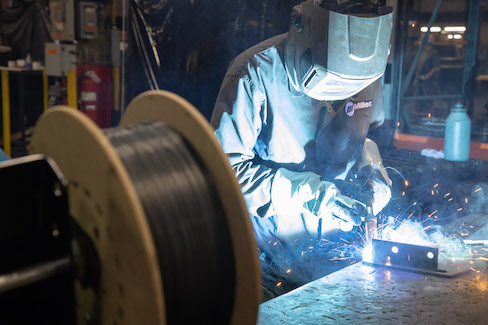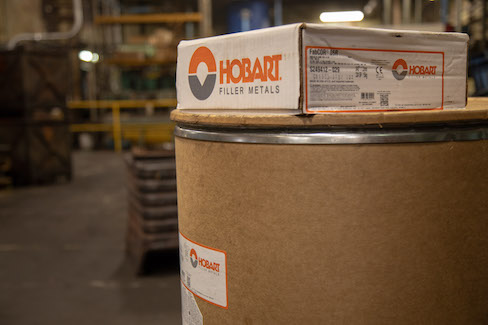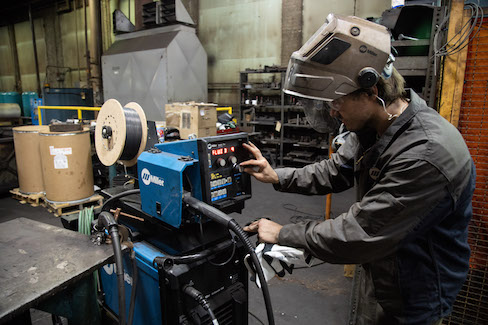Four Tips for Developing an Effective In-House Welder Training Program
Even seasoned welders don’t always remember – if they ever learned – all the basics regarding techniques and materials. Optimize fabricating operations and help plug your future skilled-labor gap by instilling good habits from the start.
Posted: May 6, 2020
WELDING TIPS COLUMN
BY JOSH ALLEN
With the welder shortage anticipated to reach 400,000 by 2024, more fabricators are implementing in-house training programs to address future labor needs. These programs allow qualified personnel to train and certify individuals who show an aptitude for welding but may have never held a MIG gun, stick electrode stinger, or TIG torch. They’re also a chance to ensure employees with some experience weld to company standards.
In many cases, welding equipment and filler metal manufacturers can assist with these programs by taking a “train the trainer” approach — teaching foremen, shop leads, and supervisors so they’re armed with the knowledge to pass onto new employees.
Effectively training new welders goes beyond teaching basic techniques, though. It also requires instilling good habits from the start — habits that apply to the overall process and begin before striking an arc. There are four key areas to consider.
A Safe Environment is a Productive Environment
Safety should be any training program’s first and top priority. Welders must become familiar with the power source or power sources they’ll be using, following the manufacturer’s manuals for safe setup and operation.
Teach new welders about any relevant company safety practices, safe use of filler metals according to the safety data sheet (SDS), proper ventilation (particularly to keep their head out of the weld plume), and to check ground connections and connections along the MIG gun or TIG torch cables to reduce the risk of electrical shock.
Personal protective equipment (PPE) is essential to all of this. Ensure welders wear safety glasses under their helmet and when conducting nonwelding-related tasks in the weld cell. Other PPE to be used at all times include steel-toe boots and flame-resistant, long-sleeve jackets, pants and gloves.
Demystifying Filler Metals
Filler metals are often an overlooked and misunderstood aspect of the welding operation, and it’s not uncommon for even seasoned welders to be unfamiliar with these consumables.
Including American Welding Society (AWS) classifications in your training program ensures new welders understand the mechanical and chemical properties and operating characteristics of any wire they’re asked to work with. This information is included on the filler metal package. For example, a metal-cored wire with the AWS classification of E70C-6M H4 breaks down as follows:
- E signifies the wire is an electrode
- 7 indicates it provides a minimum of 70,000 psi tensile strength
- 0 signifies the wire is only rated for flat and horizontal positions
- C identifies that it’s a composite cored wire
- 6 refers to the wire’s chemical composition
- M indicates the wire operates with mixed gases (argon/CO2)
- H4 signifies the wire creates a weld deposit with a maximum of 4 ml of hydrogen per 100 g of weldment (considered a low-hydrogen electrode).
Other types of filler metals, such as flux-cored and solid wires, follow similar classification breakdowns including strength and gas requirements (if any). Many online references can also help new welders understand what each part of the classification means.
One important caveat: Not all filler metals with the same AWS classifications perform equally. Manufacturers must meet the minimum property requirements for a specific classification, but one wire may run differently than another. To ensure they achieve the best performance, teach welders to dial in the power source settings according to the filler metal manufacturer’s recommendations.
Welders should also learn the techniques associated with a given filler metal and welding process. For flux-cored wires, which produce a slag system, a drag or pull technique is typically best; whereas metal-cored or solid wires achieve more desirable results with a push technique. Keep in mind, varying weld joints and welding positions may require a slight change in technique as well as adjustments to machine settings.
Building the Framework for Consistent Quality
Having welding procedure specifications (WPS) is a best practice for every fabricator — and new welders should learn how to read and follow them properly. WPS provide essential information to support consistent operation and quality by standardizing such key process details as:
- Type of shielding gas mixture
- Shielding gas flow rate
- Type and diameter of filler metal
- Voltage and amperage ranges
- Wire feed speeds
- Preheat and interpass temperatures.
To verify trainees can apply the WPS in a given application, they must be tested and qualified to show they can complete specific welds to the appropriate quality. Place a welder qualification record (WQR) on file with the WPS as proof.
Likewise, filler metal data sheets include valuable information for optimizing performance.
In addition to providing current type to operate – direct current electrode positive (DCEP) and direct current electrode negative (DCEN) – data sheets provide information on the weld position (all position, flat and/or horizontal), deposition rate, contact-tip-to-work distance, welding parameters, and more. Data sheets also include conformances and approvals and diameter and packaging sizes.
Operations Manuals Matter
Pulling the trigger on a MIG gun is one thing, but setting up a power source from scratch is quite another.
Teach trainees to follow the manufacturer’s manual in addition to hands-on instruction for setup. It’s important they understand the difference between amperage and voltage, for example, and how these affect weld appearance. They should also understand the impact of adjusting wire feed speed — increasing it raises the amperage, which in turn generates greater penetration into the weld joint.
Finally, encourage trainees to keep an active and open mind about learning new technologies. While the welding industry may not evolve its technologies as quickly as others, new ones are available regularly. Being open to change — especially when the technology can help improve performance, quality and productivity — can go far in helping new welders fine tune their skills to advance their training and careers.
This is a Win-Win Proposition
Companies that conduct their own welding training and the employees who participate stand to mutually benefit.
As welders of all experience levels increase their knowledge and refine their skills, they’re able to add more value to the business as well as the welding operation. Fabricators have an opportunity to provide a solid career path of progressive responsibilities. By offering effective training and support, companies show they value their employees, which can increase retention rates by increasing job satisfaction.


















